RESEARCH
World mortality 19502000: divergence replaces convergence from the late 1980s
Mortalité mondiale sur la période 1950 - 2000 : la convergence laisse place à la divergence depuis la fin des années 80
Mortalidad mundial en 1950-2000: convergencia inicial, y divergencia a partir de finales de los ochenta
Kath MoserI,1; Vladimir ShkolnikovII; David A. LeonIII
ILecturer, Department of Epidemiology and Population Health, London School of Hygiene and Tropical Medicine, Keppel Street, London WC1E 7HT, England (email: kath.moser@lshtm.ac.uk)
IIHead of Data Laboratory, Max Planck Institute for Demographic Research, Rostock, Germany
IIIProfessor, Department of Epidemiology and Population Health, London School of Hygiene and Tropical Medicine, London, England
ABSTRACT
OBJECTIVE: We sought to investigate to what extent worldwide improvements in mortality over the past 50 years have been accompanied by convergence in the mortality experience of the world's population.
METHODS: We have adopted a novel approach to the objective measurement of global mortality convergence. The global mortality distribution at a point in time is quantified using a dispersion measure of mortality (DMM). Trends in the DMM indicate global mortality convergence and divergence. The analysis uses United Nations data for 19502000 for all 152 countries with populations of at least 1 million in 2000 (99.7% of the world's population in 2000).
FINDINGS: The DMM for life expectancy at birth declined until the late 1980s but has since increased, signalling a shift from global convergence to divergence in life expectancy at birth. In contrast, the DMM for infant mortality indicates continued convergence since 1950.
CONCLUSION: The switch in the late 1980s from the global convergence of life expectancy at birth to divergence indicates that progress in reducing mortality differences between many populations is now more than offset by the scale of reversals in adult mortality in others. Global progress needs to be judged on whether mortality convergence can be re-established and indeed accelerated.
Keywords: Mortality/trends; Life expectancy/trends; Health status indicators; Time factors (source: MeSH, NLM).
RÉSUMÉ
OBJECTIF: Les auteurs ont cherché à étudier dans quelle mesure les améliorations des taux de mortalité enregistrées dans le monde au cours des cinquante dernières années s'étaient accompagnées d'une convergence dans la manière dont la mortalité touchait la population mondiale.
MÉTHODES: Les auteurs ont adopté une nouvelle approche pour obtenir une mesure objective de la convergence de la mortalité dans le monde. Ils quantifient la distribution de la mortalité mondiale à un instant donné au moyen d'une mesure de la dispersion de la mortalité (DMM). Les tendances de cette mesure reflètent la convergence ou la divergence de la mortalité dans le monde. L'analyse fait appel aux données des Nations Unies pour la période 1950-2000 concernant l'ensemble des 152 pays dont la population atteignait au moins 1 million d'habitants en l'an 2000 (99,7 % de la population mondiale en l'an 2000).
RÉSULTATS: La mesure de la dispersion relative à l'espérance de vie à la naissance a diminué jusqu'à la fin des années 80, mais remonté depuis, ce qui traduit un revirement de la convergence à la divergence de ce paramètre à l'échelle mondiale. En revanche, la mesure de dispersion relative à la mortalité infantile fait apparaître un maintien de la convergence depuis 1950.
CONCLUSION: Le passage à la fin des années 80 d'une convergence mondiale de l'espérance de vie à la naissance à une divergence de ce paramètre indique que les progrès dans le nivellement des différences de mortalité entre de nombreuses populations sont maintenant plus que compensés par l'ampleur des inversions subies par la mortalité adulte dans d'autres populations. Il convient d'évaluer le progrès mondial en fonction de la possibilité de rétablir la convergence de la mortalité et même de l'accélérer.
Mots clés: Mortalité/orientations; Espérance vie/orientations; Indicateur état sanitaire; Facteur temps (source: MeSH, INSERM).
RESUMEN
OBJETIVO: Decidimos investigar hasta qué punto las mejoras mundiales de la mortalidad registradas a lo largo de los últimos 50 años se han acompañado de un proceso de convergencia en la experiencia de mortalidad de la población mundial.
MÉTODOS: Hemos adoptado un nuevo procedimiento para medir objetivamente la convergencia de la mortalidad mundial. La distribución de ésta en un determinado momento se evalúa mediante una Medida de Dispersión de la Mortalidad (MDM), cuya tendencia muestra la convergencia y divergencia de la mortalidad mundial. El análisis utiliza datos de las Naciones Unidas sobre el periodo 1950-2000 para los 152 países que poseían al menos un millón de habitantes en el año 2000 (el 99,7% de la población mundial de ese año).
RESULTADOS: La MDM para la esperanza de vida al nacer disminuyó hasta finales de los años ochenta, pero ha vuelto a aumentar desde entonces, lo que pone de manifiesto una inflexión del proceso inicial de convergencia mundial. Sin embargo, la MDM correspondiente a la mortalidad en la niñez muestra una convergencia ininterrumpida desde 1950.
CONCLUSIÓN: La inflexión registrada a finales de los años ochenta en las tendencias de la esperanza de vida al nacer, de una convergencia mundial a una situación de divergencia, indica que las mejoras de reducción de las diferencias de mortalidad entre numerosas poblaciones se han visto contrarrestadas ampliamente por la magnitud de los retrocesos que ha sufrido la mortalidad adulta en otros casos. Los progresos mundiales en este campo deberán calibrarse en función de si es posible restablecer, o incluso acelerar, la convergencia de la mortalidad.
Palabras clave: Mortalidad/tendencies; Esperanza de vida/tendencias; Indicadores de salud; Factores de tiempo (fuente: DeCS, BIREME).
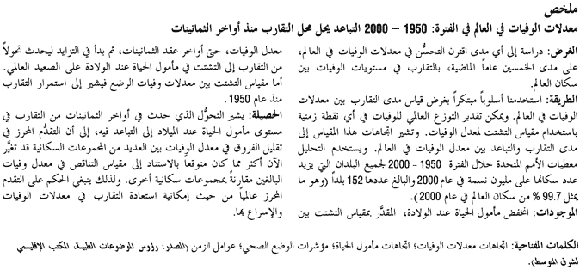
Introduction
The international community is paying increasing attention to the formulation and use of indicators and targets against which human development can be measured. The Millennium Development Goals, for example, have been widely adopted and provide a focus for the diverse attempts being made to improve the health and welfare of the world's population (1). Mortality is included in these goals as well as being a component of the well established Human Development Indices used in the Human Development Report (2).
The 2003 Human Development Report focuses on the Millennium Development Goals and states: "The range of human development in the world is vast and uneven, with astounding progress in some areas amid stagnation and dismal decline in others. Balance and stability in the world will require the commitment of all nations, rich and poor, and a global development compact to extend the wealth of possibilities to all people." Thus there is a central vision of reducing global inequities, and this vision is shared by the Director-General of WHO (3, 4). With respect to income, there is an established tradition of using measures such as the Gini coefficient to estimate trends in global inequities (5). However, with respect to health, there are no quantitative indicators being used to summarize the extent to which the mortality experience of the world's population is converging over time. In this paper we present a novel measure, the dispersion measure of mortality (DMM), that performs precisely this function. Before discussing this measure it is necessary to describe global trends in mortality.
Over the past 50 years major demographic changes have affected all regions and countries. As a result of changes in fertility and mortality the world's population has increased from 2.5 billion to 6 billion. Declines in mortality rates, especially during childhood, have been particularly remarkable (Fig. 1). For the world as a whole life expectancy at birth has increased from 46.5 years during the period 195055 to 65.0 years during the period from 1995 to 2000 (Fig. 2). However, over the past decade the belief that we were on a path of inexorable improvement in mortality that would benefit people all over the world has been undermined. In the 1990s the impact of the human immunodeficiency virus/acquired immune deficiency syndrome (HIV/AIDS) epidemic, particularly in sub-Saharan Africa (6), and the serious health crisis in the former Soviet Union (7) have shown that mortality reversals can no longer be regarded as rare and exceptional phenomena. The situation we find ourselves in is new. Before the 1970s there were almost no examples of long-term reversals in mortality, with the obvious exceptions of those caused by war and famine. Reflecting this, many of the classic analyses of the 1970s that examined long-term demographic and epidemiological trends considered that further significant gains in longevity in countries with low mortality were unlikely but that death rates in countries with high mortality would fall, resulting in a worldwide convergence in mortality (8, 9).

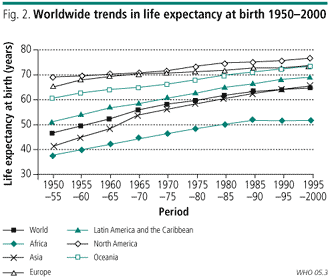
The recent reversals of mortality highlight an important question: that is, to what extent have the improvements in mortality over the past 50 years been accompanied by convergence in the mortality experience of the world's population? Given the importance of this question it is striking that few researchers have attempted to explicitly address it. Mortality convergence is discussed by McMichael et al. who raise concerns about whether it can be sustained given recent setbacks (10). Similarly Wilson, in a systematic attempt to address the issue, concluded that there had indeed been convergence over the past 50 years (11). However, neither paper provided a quantitative summary measure of global mortality convergence.
Methods
We adopted a novel approach to measuring global mortality convergence, making use of a simple measure to provide a DMM calculated for consecutive 5-year periods from 1950 to 2000. Trends in the DMM indicate global convergence and divergence. Our analysis uses estimates of life expectancy at birth, infant mortality, and live births for 10 five-year periods (195055 to 19952000) and population estimates for midpoints of these periods (1952, 1957, 1962, etc.) taken from the United Nations 2000 revision of World population prospects (12). We also used data on mortality occurring among children less than 5 years old for 199095 and 19952000, the only two periods for which such data are available. Data from all 152 countries with populations of at least 1 million in 2000 were used. The excluded countries, mainly small island states, accounted for 0.27% of the world's population in 2000. Mortality trends in the only 10 excluded countries where the population exceeded 500 000 are similar to those of the countries included in the analysis.
Dispersion measure of mortality
The DMM measures the degree of dispersion that exists at any point in time in the mortality experience of the world's population. It is calculated as the average absolute inter-country mortality difference, weighted by population size, between each and every pair of countries. This approach draws on more generic mathematical work on measures of dispersion (13). Changes in the DMM over time indicate whether mortality is becoming more or less similar across the globe; decreases indicate convergence, while increases indicate divergence. The DMM for life expectancy at birth is measured in years of life, and the DMM for infant mortality is measured in infant deaths per thousand live births. So
 where:
where:
i, j are countries, and 1 < i, j < 152
z is the world
M is the mortality rate
W is the weighting, and 
When applied to life expectancy at birth, M = life expectancy at birth, Wz = 1 and Wi represents relative population size of country i adjusted, however, in order to ensure that

This adjustment is made because, generally speaking, the weighted average of country-specific life expectancies does not equal overall life expectancy (because life expectancies are based on life table stationary populations that differ from real populations). A simple transformation of population weights allows us to obtain weights so that the above equation is true while ensuring the minimum deviation from the original population weights (14). In the case of infant mortality, M = infant mortality rate and W = live births (as used for the denominator in calculating the infant mortality rate).
The routinely available mortality data used to construct the DMM are also used widely elsewhere (for example in the human development indices). However, the validity of all applications of global mortality data is subject to concerns about the quality of the data. For many countries the demographic data used to construct global indices are imprecise. In order to examine how far the trends in the DMM that we report could reflect these concerns, and in particular for recent changes, we undertook a series of sensitivity analyses.
The data are poorest for sub-Saharan Africa, the region where two-thirds of the countries experiencing recent mortality reversals are situated. Could data quality alone have accounted for our findings? If the reversals had been greater or had occurred in more countries than indicated by the data, or both, then our findings of divergence would stand. However, to test whether the findings would hold even if the documented reversals exaggerated the real situation we hypothesized that in the 24 countries with reversals occurring between 198085 and 19952000 that firstly, the decline in life expectancy at birth was actually only half that indicated by the data, and secondly that mortality had stagnated but not reversed. (These two scenarios were chosen in order to make generous allowances for data quality.) Mortality in the remaining countries was as indicated by their data. In both cases we recalculated the DMM using the hypothetical data.
India and China have played an important part in world demographic trends as a result of contributing 3540% of the world's population. Consequently, these countries have a very large weighting in the calculation of the DMM. We tested whether replacing national data with subnational data for India (25 states) and China (28 provinces), thereby making the units of analysis nearer in size to other countries, had any bearing on our findings.
Findings
Between 1950 and the late 1980s the DMM for life expectancy at birth fell progressively after which time it started to increase (Fig. 3). Thus a long period of global convergence in life expectancy at birth has been replaced since the late 1980s by divergence. This occurred despite the fact that global life expectancy at birth improved throughout the period 19502000 (Fig. 2).
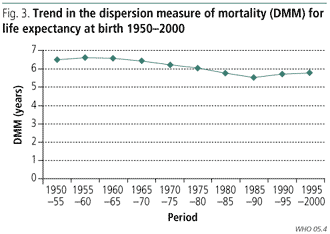
In order to see what lies behind these summary trends we looked at net changes in life expectancy at birth for individual countries in three consecutive 1520 year periods. Over the first period, 195055 to 196570, life expectancy at birth increased in all countries (Fig. 4a). Increases ranged from 112 years (with the exception of China where the increase was almost 19 years); the smallest increases occurred mostly in countries with low mortality. In most countries life expectancy at birth continued to improve over the period 196570 to 198085, although in parts of the former Soviet Union, including the Russian Federation, life expectancy fell and in many countries in central and eastern Europe it stagnated (Fig. 4b). Most recently (198085 to 19952000) the pattern became much more diffuse, with 24 countries (accounting for 7.6% of the world's population in 1997) experiencing falls in life expectancy at birth (Fig. 4c). Situations in these countries spanned high mortality to low mortality and included 16 (out of 41) countries in sub-Saharan Africa, the remainder being in Asia and the former Soviet Union. In eight countries (in sub-Saharan Africa and the Democratic People's Republic of Korea) life expectancy fell by more than 5 years.
Given that infant mortality is an important component of life expectancy at birth it might be expected that trends in the DMM for this outcome would be the same as those for life expectancy at birth. However, in contrast to the trend for life expectancy at birth, the DMM for infant mortality decreased throughout the entire period 19502000, indicating persistent convergence over the past 50 years (Fig. 5). A more detailed analysis (not shown) concludes that during the first two 1520 year periods all countries had a net decrease in infant mortality. However, between 198085 and 19952000 there was a net increase in infant mortality in 5 of the 152 countries, although these reversals were clearly not sufficient to reverse the overall trend of global convergence in infant mortality.

The DMM for mortality among children younger than 5 years (for the two data points available) decreased from 32.6 in 199095 to 31.2 in 19952000, indicating that convergence occurred during the 1990s.
Of the 24 countries experiencing net declines in life expectancy at birth between 198085 and 19952000, 19 (in sub-Saharan Africa and the former Soviet Union) showed simultaneous improvements in infant mortality (Fig. 6). The remaining five countries (Botswana, Burundi, Iraq, Kazakhstan, and the Democratic People's Republic of Korea) experienced deteriorations in both infant mortality and life expectancy at birth. The causes behind these exceptional trends are likely to be diverse, although they will include the health effects of political and economic isolation, as in the cases of Iraq and the Democratic People's Republic of Korea.
When the mortality reversals between 198085 and 19952000 were assumed to be only half the size indicated by the data, the DMM trend for life expectancy at birth still showed a slight divergence in mortality in the 1990s preceded by a slight convergence between the late 1980s and early 1990s (Fig. 7a). When mortality was assumed to have stagnated but not reversed in these same 24 countries, the recalculated trends indicated continued convergence (Fig. 7b). Replacing national data with subnational data for India and China for the two time periods tested increased the DMM in 195055 from 6.5 to 6.8 years and decreased it in 19751980 from 6.0 to 5.9 years.
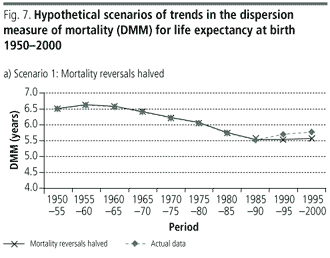
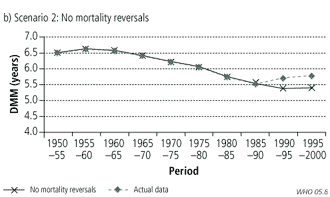
Discussion
This paper provides the first systematic quantification of global mortality convergence. It shows that the former trend of worldwide convergence towards low mortality has reversed. For life expectancy at birth, the switch in the late 1980s from convergence to divergence tells us that humanity has entered a phase during which progress in reducing mortality differences between many populations is now more than offset by the scale of the mortality reversals seen in others, notably in parts of sub-Saharan Africa and the former Soviet Union. Since the late 1980s the world has not only failed to become a more equal place in terms of mortality, but it has actually become less equal. This has occurred despite continued general improvements in mortality as reflected in the trends in global life expectancy at birth and infant mortality.
The fact that we observed recent global divergence in life expectancy at birth while infant mortality continues to converge indicates that it is mortality reversals occurring among those aged older than 1 year that are driving the divergence. The fact that in the 1990s we also saw convergence in mortality among children less than 5 years old indicates that the divergence during this decade is not the result of child mortality. We conclude, therefore, that the shift from global convergence to divergence is being driven by reversals in adult mortality. With respect to the former Soviet Union, including the Russian Federation, there is strong evidence that the reversals in life expectancy at birth are almost exclusively due to increases in adult mortality (7).
The DMM provides a novel approach to objectively measuring global mortality convergence; it goes beyond an enumeration of the countries showing improvements or reversals in mortality. The DMM quantifies the global dispersion of mortality at a point in time, and trends in the DMM indicate whether mortality of the world's population is, on aggregate, becoming more similar or less similar. In using information for all countries with a population of at least 1 million and weighting for the population size of each country (or live births in the case of infant mortality) the DMM has advantages over other commonly used summary measures of mortality contrast that only use information from the extremes of the mortality or socioeconomic distribution and do not weight for size of the unit. Being based on absolute differences in mortality, the DMM avoids a problem frequently encountered when using relative measures to examine time trends in inequality. Relative measures are strongly affected by the value of the reference mortality rate and consequently, in periods of falling mortality, tend to increase over time as the denominator decreases. The DMM provides different and complementary information to that given by the overall mortality level. Progress in one does not necessarily imply progress in the other. Global mortality rates may improve while the mortality distribution worldwide simultaneously diverges (in other words becomes less equitable).
Wilson, in his assessment of mortality convergence, failed to identify this transition from convergence to divergence in the late 1980s (11). This was primarily due to the fact that he contrasted three non-adjacent time periods (195055, 197580, 2000) and hence failed to capture the period of reversal that occurred between the last two periods. In addition, he did not use a summary statistic and relied instead upon visual inspection of graphical data and on interquartile ranges that use only part of the available information.
Data source and quality
Before discussing these findings further it is important to mention the issue of data quality, although quality is an issue for any measures that use global mortality data to look at trends over time. The United Nations data used for this analysis are the best that are available for long-term trends. However it is well known that the source and quality of demographic data varies from place to place and over time. Most of Europe, north America (the USA and Canada) and Oceania had good registration systems and regular censuses covering the whole of the period studied. In contrast, many low- and middle-income countries, with the exception of some in Latin America and south-east Asia, have no (or incomplete) registers of births and deaths. In particular, it is worth noting that data are poorest in sub-Saharan Africa. Questions are asked in surveys and censuses in such countries on child survival, birth histories, orphanhood, sibling histories, and recent deaths in the household. Responses to these questions are often the main source of demographic information for such countries, from which indirect methods are used to estimate mortality and fertility (6, 1517).
The quality of mortality data in itself is unlikely to affect trends in the DMM, although it may affect the absolute level of the DMM. The sensitivity analyses we undertook indicate that our findings remain the same even if we use some worst-case scenarios for data quality. Global divergence in life expectancy at birth would still be apparent in the 1990s even if the mortality reversals were only half the size indicated by the data. Moreover, no global divergence would be apparent in recent years if the countries whose data indicated reversals actually only had stagnating mortality. In other words, we conclude that the global divergence we observe results from mortality reversals in some countries alongside continued improvements in others.
Implications for policy
We suggest that global convergence in mortality needs to be adopted by the international community as one of the criteria for judging progress towards a more equitable world. The DMM has the potential to do this simply and transparently. It is a tool that can be used to monitor moves to reinstate and accelerate the trend towards global mortality convergence.
A prerequisite for effectively analysing and monitoring trends and formulating policy is the availability of reliable and comprehensive data. The crucial importance of improving data and developing better statistical measures has been highlighted (2, 18), and with the development of the Health Metrics Network (19) there are hopes that the need to strengthen health information systems will be seriously addressed.
The Millennium Development Goals have been internationally accepted as a framework for setting development objectives (1). With respect to mortality per se their main focus is on reducing mortality among children less than 5 years old. However, as this paper has shown, mortality among children is not the main factor behind the global divergence in life expectancy at birth. Our analysis suggests that adult mortality should be given greater emphasis as a global public health priority than is the case in the Millennium Development Goals (20).
Conclusion
Although in one sense the world has become a better place as mortality declines, in another way it has become worse as the distribution of life expectancy at birth worldwide has started to diverge; this indicates that global inequality in mortality is increasing. So far this divergence is relatively small and has been of limited duration compared with the earlier convergence. What is not clear is whether the divergence will continue or become larger or whether it will be reversed. Moreover, there are worrying signs that unless action is taken we may for the first time see global divergence in childhood mortality (2, 21). It is essential that policy-makers address these serious developments. The direction of future trends depends upon action today. Future global progress should be judged not only in terms of whether overall life expectancy continues to improve but also according to whether mortality convergence can be re-established and accelerated. The Dispersion Measure of Mortality offers a simple summary measure that can be used to monitor progress in this direction. 
Acknowledgements
We are very grateful to Chris Wilson for providing us with estimates of life expectancy at birth for the states of India and provinces of China (see ref. 11 for a full description of these data). The authors thank Andy Haines, Martin McKee, Liam Smeeth, Ian Timaeus and Gill Walt for their comments on an earlier draft of this paper.
Funding: Kath Moser is supported by the Dreyfus Health Foundation.
Conflicts of interest: none declared.
References
1. United Nations Millennium Project. Millennium development goals, 2000. Available from: http://www.unmillenniumproject.org/html/dev_goals.shtm
2. United Nations Development Programme. Human development report 2003. New York: Oxford University Press; 2003.
3. Lee JW. Global health improvement and WHO: shaping the future. Lancet 2003;362:2083-8.
4. World Health Organization. The world health report 2003 Shaping the future. Geneva: WHO; 2003.
5. Korzeniewicz RP, Moran TP. World economic trends in the distribution of income, 1965-1992. American Journal of Sociology 1997;102:1000-39.
6. Timaeus I. Impact of the HIV epidemic on mortality in sub-Saharan Africa: evidence from national surveys and censuses. AIDS 1998;12 Suppl 1:S15-27.
7. Shkolnikov V, McKee M, Leon D. Changes in life expectancy in Russia in the mid-1990s. Lancet 2001;357:917-21.
8. Preston SH. Mortality patterns in national populations. New York: Academic Press; 1976.
9. Omran AR. The epidemiological transition: a theory of the epidemiology of population change. Milbank Memorial Fund Quarterly 1971;49:509-38.
10. McMichael AJ, McKee M, Shkolnikov V, Valkonen T. Mortality trends and setbacks: global convergence or divergence? Lancet 2004;363:1155-9.
11. Wilson C. On the scale of global demographic convergence 1950-2000. Population and Development Review 2001;27:155-71.
12. United Nations. World population prospects: the 2000 revision. New York: United Nations; 2001.
13. Kendall M, Stuart A. The advanced theory of statistics. vol 1. 4th ed. London: Charles Griffin; 1977.
14. Shkolnikov V, Valkonen T, Begun A, Andreev E. Measuring inter-group inequalities in length of life. Genus 2001;LVII:33-62.
15. Brass W. Demographic data analysis in less developed countries: 1946-1996. Population Studies 1996;50:451-67.
16. Timaeus I. Mortality in sub-Saharan Africa. In: Chamie J, Cliquet R, editors. Health and mortality: issues of global concern. New York: Population Division, United Nations and Population and Family Study Centre, Flemish Scientific Institute; 1999. p. 108-31.
17. United Nations. World Population Prospects: the 2000 revision. Volume III: Analytical report. New York: United Nations; 2002.
18. Lee JW. Speech to the Fifty-sixth World Health Assembly, 2003. Available from: http://www.who.int/dg/lee/speeches/2003/21_05/en/
19. Evans T, Stansfield S. Health information in the new millennium: a gathering storm? Bulletin of the World Health Organization 2003;81:856.
20. Lock L, Andreev E, Shkolnikov V, McKee M. What targets for international development policies are appropriate for improving health in Russia? Health Policy and Planning 2002;17:257-63.
21. Victora CG, Wagstaff A, Schellenberg JA, Gwatkin D, Claeson M, Habicht JP. Applying an equity lens to child health and mortality: more of the same is not enough. Lancet 2003;362:233-41.
Submitted: 18 March 2004 Final revised version received: 19 July 2004 Accepted: 13 September 2004
1 Correspondence should be sent to this author.
